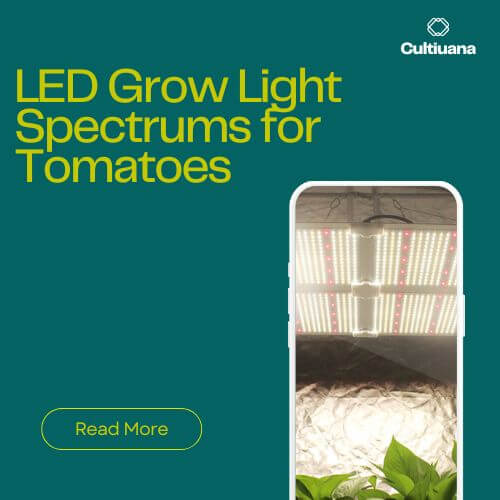How To Use Grow Lights For Indoor Plants
Lights used to be one of the most expensive aspects of indoor plants cultivation. A set of HPS lights and the required equipment could cost several hundred dollars. Growing indoor plants at home is now more accessible, thanks to LED grow lights, which keep the cost of indoor plants grow lights lower.
If you’re looking to get into gardening indoors with LED grow lights, this article has everything you need to become a successful gardener. Whether you choose to follow the advice in it will depend on your experience as an indoor gardener.
Different Types of LED Grow Lights

The goal of any grow light is to provide the right intensity of light, as well as consistency, so the plant's nutrition levels can be what they need to be.
Imagine if you were supplying 800 μmol/s/m2 to the center of the room and 300 μmol/s/m2 to the edges. How do you distribute the nutrition? Basically, more light equals more nutritional demands, so feeding based on the edge light level will starve the plants in the center while feeding based on the center light level will burn the plants in the edge.
Here we outline the ideal LED grow fixture designs per growth stage as we experienced:
Cloning Lights
Clones need the least amount of light of all stages of plant growth but still need uniformity. Many growers ignore their cloning lights: they just set up a T5 fluorescent lamp for their plants.
However, it is very common for clones under T5 lighting to receive 300 μmol/s/m2 directly under the center of the bulbs, but only 50 μmol/s/m2 at the edges. With this situation, you can imagine how difficult the cloning process was.
The grower should verify the light levels at those distances to ensure that they are appropriate for vulnerable cuttings. Cuttings should not be exposed to too much light; the light manufacturer should recommend maximum and minimum distances from the fixture to the tops of the clones to deliver the correct lighting level. When using adequate clone lights, dimming is rarely (if ever) required.
Vegetative Lights
Vegetative lights allow you to have your plants grow roots and leaves so they can become big and strong before beginning their flowering cycle. Some good tips for choosing the right setup include maintaining high blue to red ratios and having a uniform lighting intensity. The goal should be an even light distribution throughout your vegetative light deployment, especially if you have multiple lamps being used.
It's a good idea to lower the lights in your vegetative stage. This allows for permanent positioning of your lights, so you don't have to worry about them getting in the way when it comes time for your plants to flower.
Flowering Lights
Flowering lights are the most common in indoor grow spaces. It's no surprise because these lamps were always specifically made for plant growth rather than for any other reason.
We grow indoor crops and need a flowering light that has full dimming capabilities and the ability to independently control white, red, and far-red LEDs to regulate its levels of intensity. In addition, the desired initial photon density will come from the white LED with the red and far-red being initially turned off.
Plants need to receive red light during their flowering phase and they also need a good amount of blue. The ideal flowering light would contain the spectrum with large amounts of red, a lot of blue, and smaller, but still substantial, amounts of yellow, green and orange. And it should also contain some UV and IR light.
The Advantages of Growing With LEDs:

We've already mentioned 17 advantages of growing with LEDs in this article. LED grow lights offer many advantages over traditional grow lighting. These benefits include:
- higher efficiency
- full spectrum
- even light distribution
- less heat output
- less power
- longer lifespan
- cooler operation
- smart controlling
- closer hangin to the canopy
- versatility
- lower maintaining
- easy to install
- healthier plants
- environmental friendly
- government rebates
- daisy chainable
- multiple application
Growing With LEDs:
Maintaining The Environment
Maintaining a healthy indoor environment is crucial when it comes to gardening. This factor might even be more important than the plant genetics, plant nutrition, and lighting fixtures you have access to in some cases. Heat-stressed and dry plants just don't do well at all no matter what else you do for them.
In this table, we give some information about environmental conditions to maintain when growing the crops commercially. Your environment may need adjustments if you're growing a specific strain.
| Leaf Temp(°C) | CO2(ppm) | Humidity(%) | Light Cycle | PPFD(umol/s/m2) | |
| Clones | 25-27 | 400 | 75-90 | 18 ON 6 OFF | 100-125 |
| Seeds | 25-27 | 400 | 60-70 | 18 ON 6 OFF | 200-300 |
| Vegetative | 26-28 | 600-800 | 60-70 | 18 ON 6 OFF | 200-600 |
| Early Flower | 26-28 | 1000-1200 | 55-65 | 12 ON 12 OFF | 700-800 |
| Mid Flower | 26-28 | 1200-1500 | 55-60 | 12 ON 12 OFF | 800-1000 |
| Late Flower | 26-28 | 1200-1500 | 50-55 | 12 ON 12 OFF | 1200-1500 |
Stages of Plant Growth

Cloning
Growing clones using LEDs produced strong, bushy roots on clones as well as cuttings. A large majority of clones were successfully rooted under LEDs. The studies indicate that a higher blue-to-red ratio encourages cuttings to root faster than other types of light.
To start off rooted clones should have 200 μmol/s/m2 of light for a few days and then increase the lighting levels by 25 μmol/s/m2 daily until the desired level is achieved.
Too much light may be an issue for newly rooted clones as they do not produce their own energy. This can easily happen if your space is too exposed to light or if you expose them to too much artificial lighting, even for a short amount of time. If this happens, it will start using up the carbohydrates stored in its stems and leaves and could eventually kill it in the process.
Seedlings
As soon as your plant has sprouted from its seeds, you will need to make sure it is receiving plenty of light to grow.
They are far more sensitive to intense light compared to mature indoor plants, so you must be cautious with the intense lights of LEDs. Seeds need more light than clones, 300 μmol/s/m2 is a good start point for a leafy plant, and then keep increasing the PPFD levels by 25 μmol/s/m2 daily.
Vegetative
Once a seedling develops 7 sets pointed leaves, it enters vegetative growth.
This is the stage where growers will begin topping and training plants. The plants are still tender, so watch your PPFD.
Once the plants are in the vegetative stage, they will need to be provided with more light than what they received during clones or seedlings. You should aim for 300 PPFD during early vegetative stage and 500 PPFD during late vegetative phase.
Flowering
When plants have established themselves through the vegetative stage, it's time to flip the lights in order for them to begin flowering. It is necessary to change their lighting cycles to 12 hours on and 12 hours off, and increase the PPFD by 10-20% beyond what they received in the vegetative stage.
It is recommended that a grower use at least 600 PPFD during this stage. We see that in one square foot at 12", directly underneath the light, the PPFD is 740-780 PPFD on average. By moving the light to about 14"/35cm, the grower can expect a PPFD of 600-650 PPFD, increasing coverage slightly.
The grow is massive.LED grow lights are a great way to get started with growing plants indoors. They provide the light that plants need to grow, and they can be adjusted to provide the right amount of light for different stages of growth. For example, you may want more blue light during vegetative growth or more red light during flowering. The best place to find information about how these work is online, where there are many tutorials about indoor gardening in general as well as specific instructions on how to use grow lights for indoor plant care. With the next generation of LED grow lights, every garden will harvest like that one or better.




